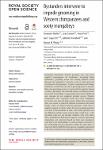Bystanders intervene to impede grooming in Western chimpanzees and sooty mangabeys
Mielke, Alexander
Samuni, Liran
Preis, Anna
Gogarten, Jan F.
Crockford, Catherine
Wittig, Roman M.
Grooming interactions benefit groomers, but may have negative consequences for bystanders. Grooming limits bystanders' grooming access and ensuing alliances could threaten the bystander's hierarchy rank or their previous investment in the groomers. To gain a competitive advantage, bystanders could intervene into a grooming bout to increase their own grooming access or to prevent the negative impact of others' grooming. We tested the impact of dominance rank and social relationships on grooming intervention likelihood and outcome in two sympatric primate species, Western chimpanzees (Pan troglodytes verus) and sooty mangabeys (Cercocebus atys atys). In both species, rather than increasing their own access to preferred partners, bystanders intervened mainly when an alliance between groomers could have a negative impact on them: when the lower-ranking groomer was close to the bystander in rank, when either groomer was an affiliation partner whose services they could lose, or the groomers were not yet strongly affiliated with each other. Thus, bystanders in both species appear to monitor grooming interactions and intervene based on their own dominance rank and social relationships, as well as triadic awareness of the relationship between groomers. While the motivation to intervene did not differ between species, mangabeys appeared to be more constrained by dominance rank than chimpanzees.
No license information

